Does Virtual Try-On Technology Actually Work for Fashion?
Have you ever bought something online and spent days, even weeks waiting for it to arrive, only to have it look and fit nothing like you thought it would? You did everything right, from checking the measurements to meticulously studying the model's movements in the item to reading the reviews. What gives?
Virtual try-on (VTO) technology promises to be a painless and easy solution to end this vicious cycle. But does it really work?
VTO technology can get you in a pair of sneakers, sunglasses, jewelry, makeup or even a formal gown from the comfort of your own home just by using an app or website. Virtual experiences like these boomed in the midst of the pandemic, as retail stores kept dressing rooms closed and online shopping habits soared. Today, retailers are banking on them to fuel their revenue.
"Our research shows that 55% of online apparel shoppers have returned an item because it looked different on them than expected, and 42% say they don't feel represented by images of models while shopping for clothes," Lilian Rincon, senior director of consumer shopping product at Google (which recently launched a VTO tool), tells Fashionista.
In theory, VTO technology is the perfect solution for everyone. It allows customers to try on different styles at home, away from pushy staff, judgmental couch boyfriends and unflattering lighting. For retailers, it could mean fewer returns, higher engagement, an increase in Gen-Z and millennial customers and, most importantly, more sales — and it's proving to be successful: According to Snap, Dior saw a 6.2x return on ad spend when implementing its try-on technology.
While protecting one's privacy often deters people from experimenting with shiny new tech advancements like these, research conducted by the University of Missouri shows that these concerns are reduced when VTO is versatile and easy to use. Studies are also showing that, despite VTO lacking that important tactile element, it does effectively "mimic the window-shopping in-store experience" because of the self-decorating aspect.
Not all VTO technology is created equal, though: Earlier iterations of these solutions powered by virtual reality (VR) and augmented reality (AR) were often clunky, slow and glitchy — an experience more akin to dressing up your Sims character rather than a luxury retail one. But now, as more companies implement AI, this is improving at a rapid rate. (Plus, the AR and VR market is expected to reach $71.2 billion by 2028, up from $25.1 billion in 2023.)
We decided to test the best VTO technology offerings we could get our hands on in fashion retail, and see if this really is the future of shopping.
Snap Lens
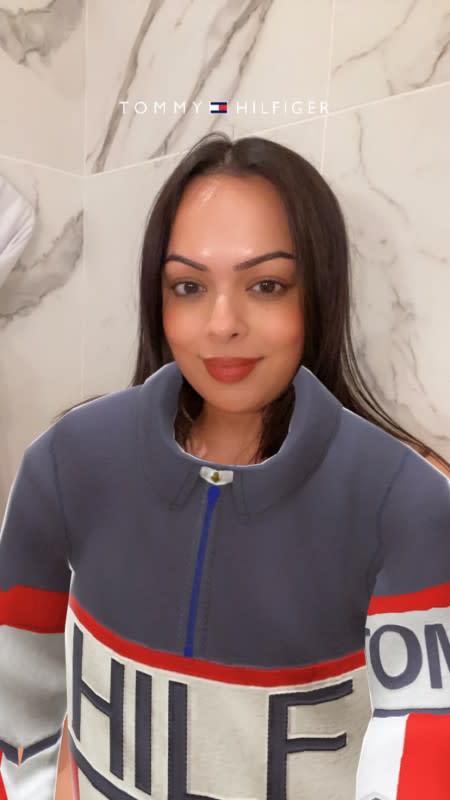
Tommy Hilfiger Snap Lens
Photo: Kish Lal
View the 4 images of this gallery on the original article
From Prada and H&M to Farfetch and Bulgari, brands and designers have flocked to Snap to take advantage of its Lens capabilities. Anyone that's used a filter on TikTok or Instagram — and was using Snapchat back when the puppy filter reigned supreme — understands how it's the easiest VTO technology to use of them all. Once you sign up for an account, you're free to scroll through filter options and, more importantly, use the search function to find designer lenses. It's easy to get lost, though, as almost every brand has a Snap account and, more often than not, a Lens.
While it's entertaining to try on different Adidas sneakers, Gucci sunglasses, Tommy Hilfiger sweaters and even Prada bags — all of which are accessible through the selfie or back camera — that's about all it is: a bit of fun. Beyond laughing at the glitchy renderings and pouting at myself in the camera while wearing oversized glasses, the VTO technology didn't really provide a realistic understanding of how items would fit my face or body, nor did the items look particularly real. It's impressive, but nothing that would send me to the designer's website to buy the item.
6/10
Wanna Wear
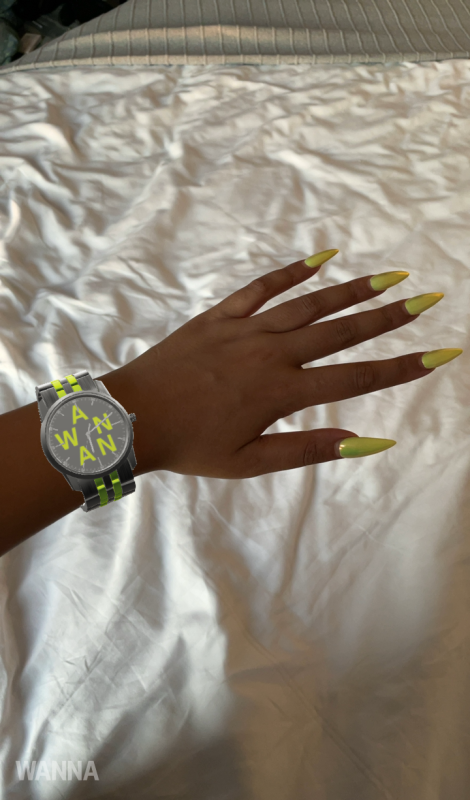
Photo: Kish Lal
Farfetch-owned AR technology company Wanna offers a sleek in-app experience through which people can try luxury items. The interface is simple and distinctly offers a timer for full-body photos. However, unlike Snap, the offerings are limited. Valentino became the first luxury brand to collaborate with the Wanna Wear app, allowing users to try on a curated selection of its men's Fall 2023 collection (including the wool and silk Valentie tie with metal 'V' applique straight off the runway); there are direct links to the Valentino website, so people can buy a piece if they like what they see.
The experience inched ahead of the Snap Lens, albeit marginally. The virtual clothing felt a little more real, but there were still no sizing options and a weird outline around my body where my real clothes peeked through the rendering. And as much as I love being a guinea pig, I wasn't about to bare my naked body to an app with a camera — at least not today. Perhaps those willing to pose in their underwear could have a better experience, but still, other issues, like necklines that grazed my chin and unrealistically boxy arms and shoulders, meant this was an experience that made me feel worse instead of immersed into the Valentino fantasy.
Using a QR code, I was also able to indulge in other unbranded Wanna experiences in Safari, trying on shoes and watches quite seamlessly. The fit was a lot better; however, these pieces were fictitious Wanna creations, not ready-to-buy items.
6.5/10
Zyler
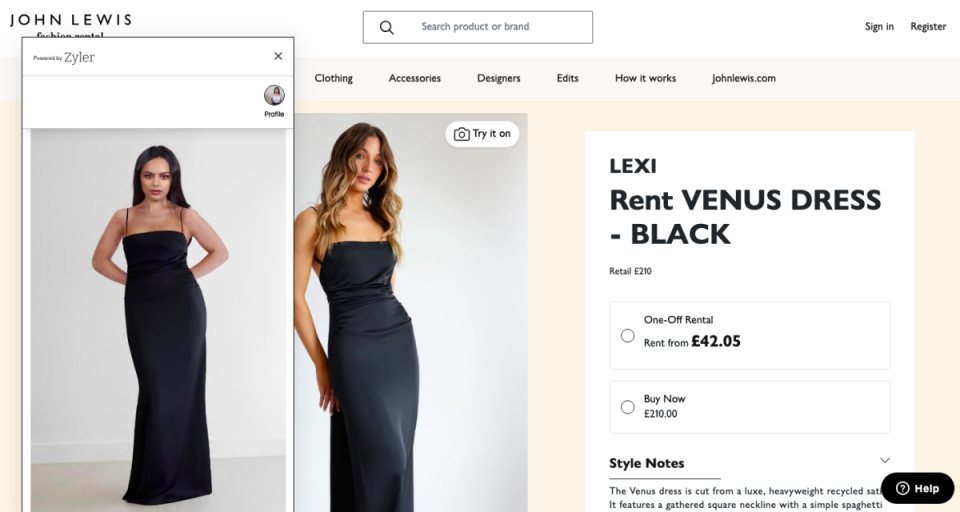
Photo: Kish Lal
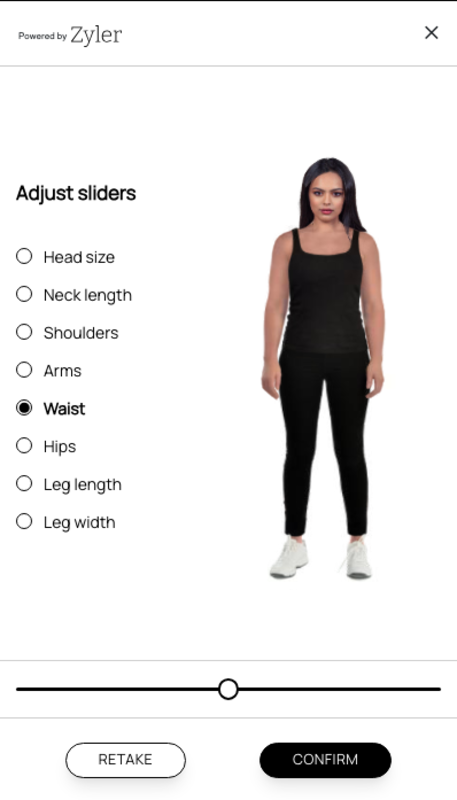
Photo: Kish Lal
VTO company Zyler has been used in-store by retailer Marks & Spencer, as well as online by Italian brand Kangra, bridal boutique Brides by Lola Dre and, most recently, John Lewis Fashion Rental.
While buying the wrong size dress is always frustrating, it's just as cumbersome getting an ill-fitting rental, so I tried out the VTO tech used for John Lewis, wondering if a desktop-integrated try-on experience would be better than the ones I had tried on my humble iPhone. Unlike the filter-esque AR try-ons from Wanna and Snap, Zyler prompts for measurements like your height, dress size and bra size before you upload a clear selfie of yourself.
If you'd rather not scroll through your photos, you can choose a stock photo of a model to try on the clothing for you. Another page with sliders enables you to change the width, length and size of your legs, neck and head, as well as adjust shoulders, arms, waist and hips. For those blessed with wide hips, short or long torsos, thicker arms or swan-like necks, this feels especially helpful. But as someone who feels quite at odds with what I really look like, I found myself stuck on this for almost five minutes, adjusting my neck one way before narrowing and widening my shoulders at least 15 times. I gave up and just went on to the next step.
And just like that, I was more-or-less superimposed onto the model's body, pose and all. My legs, arms and hips, marginally widened to fit my size-six body, but I wasn't given any sizing suggestions based on the proportions I had provided. In fact, the experience left me a little deflated… lost in thoughts like, "How big is my head…"
6/10
Walmart
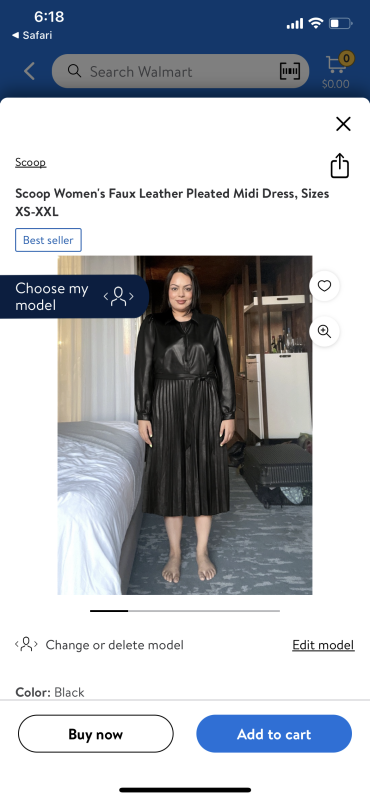
Photo: Kish Lal
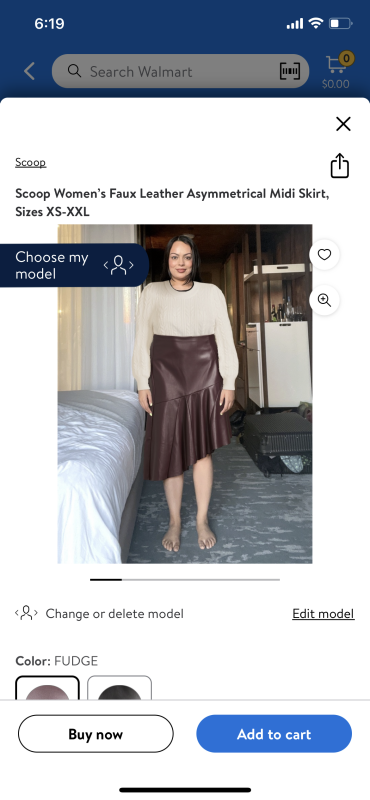
Photo: Kish Lal
Walmart may not have the most sought-after fashion pieces, but its VTO capabilities were the best I tried.
The in-app-only experience requires you to follow a step-by-step process wherein a robotic voice asks you to wear "tight shorts" and helps you set up the correct angle for your phone. (You have no choice but to strip down, so do so at your own risk.) It also directs you on where and how to stand to enable the app to take the perfect photo of you to be your own fit model. Once it snaps the photo, you're quickly and quite seamlessly superimposed onto one of over 1,000 items on the website.
As the photo used is of your full body, the results are quite realistic and don't really require you to agonize about the size of your hips or shoulders. Although, I did look pitifully frumpy in almost anything I tried on. But I couldn't decide if it was me, the clothing or the tech that was the problem.
However, after about five minutes of scrolling through items for my perfectly-posed avatar, the app forgot all about the five-minute, kind-of-awkward photoshoot we'd just had and prompted me to start the process all over again. I decided I'd had my fun, and closed the app.
8/10
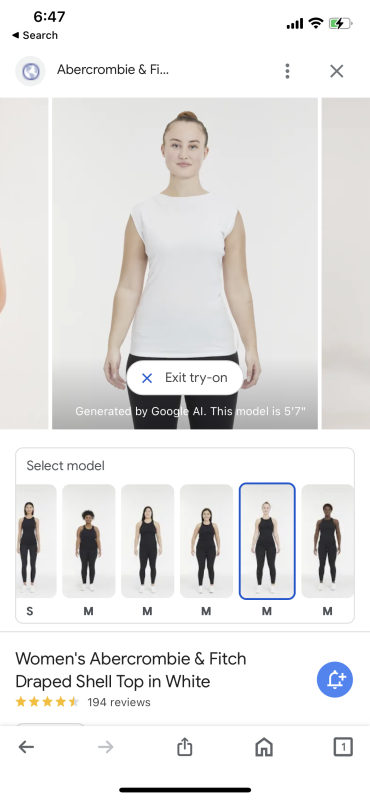
Photo: Kish Lal
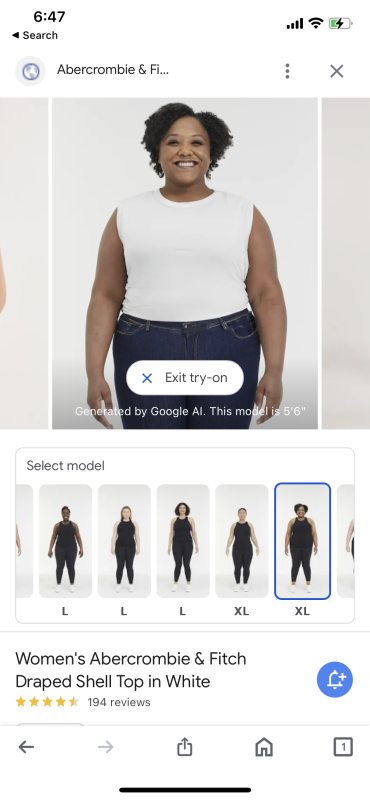
Photo: Kish Lal
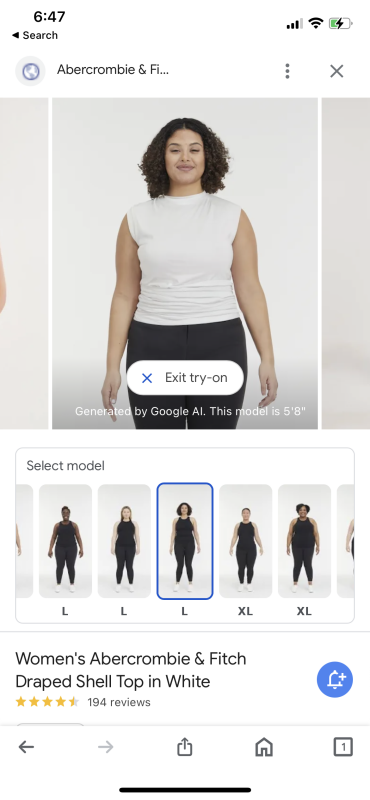
Photo: Kish Lal
In June, Google announced it would be using generative AI to update a slew of its applications, from Maps and Search to Shopping. On the latter, the tool claims to accurately show what a garment looks like on a set of 80 diverse models in various poses, ranging from sizes XXS-4XL. (Google paid real-life models for their time and photographed them from a range of angles, eschewing the new trend of using AI-generated models.) Seeing how items look on a series of models isn't by any means a new or unique retail experience, but the Google AI offering hopes to offer more nuanced information about items.
The tool is meant to illustrate subtle details of a garment, like how it would fold, cling, stretch and form wrinkles and shadows on models ranging in size, shape, skin tone and ethnicity. The experience launched with tops from select brands, including Anthropologie, Everlane, H&M and Loft. As the AI is further trained, it will be applied to any piece of apparel within Google's Shopping Graph.
This perhaps was the most exciting offering to try, but also the most difficult to find. It doesn't seem to be available on a desktop; finding it within the Chrome app on my phone was also a feat, as it wasn't easy to locate in the Shopping tab. Eventually, a cursory Google search of "women's tops" and scrolling for a while led me to see a "Try On" button on an Abercrombie top; there, there are multiple models for each size, making this the most sophisticated VTO offering I've tried.
Since the AI is in its nascent stages and available for such a limited selection, it's hard to determine whether it's a convincing VTO offering at this point in time.
7.5/10
Maria Tash
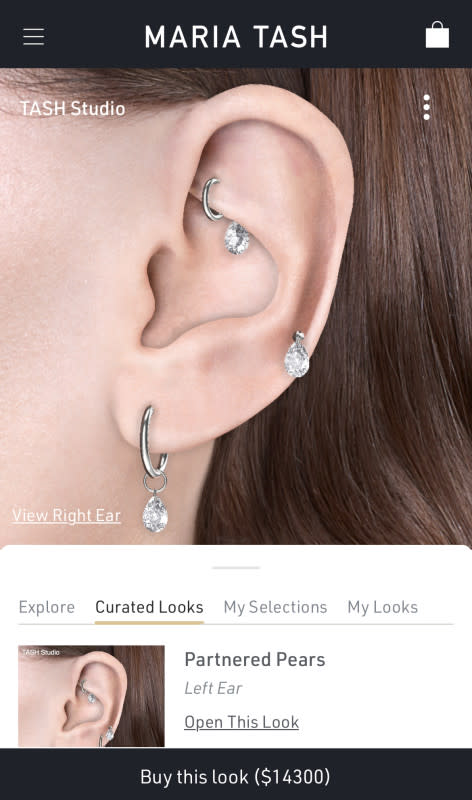
Photo: Kish Lal
Often when shopping for jewelry, especially pieces like earrings and rings, brands don't do the best job of showing how it'll look on someone. So, Maria Tash offers a VTO experience called Tash Studio, which carefully emulates how earrings will appear on your ear.
There's no need to sign up or enter any details, as it's readily available on its website. The major friction point with this technology was definitely the unskippable, kind of laborious tutorial on how to use the pretty intuitive try-on tech. (If I don't know how to drag an image of an earring to a giant ear, would I even be using VTO in the first place?) While I do see the benefit of the tutorial for others new to the technology, it would still be nice to have an option to skip it.
Once I finally got to the VTO, it was actually quite fun: You can choose one of four skin tones for your giant ear mannequin, view both ears at once or spend time adorning one ear at a time. In terms of technology, it doesn't feel especially innovative or futuristic, but it does do a really good job of allowing you to pick different products and understand how they'd look and their true size, as well as work out which placements you want each earring for. There are also some suggested curated looks that generate the embellished ear of any piercing lover's dreams.
Even as someone with zero piercings, the experience was the first I'd use that successfully provided an idea of sizing.
7.5/10
Ray-Ban
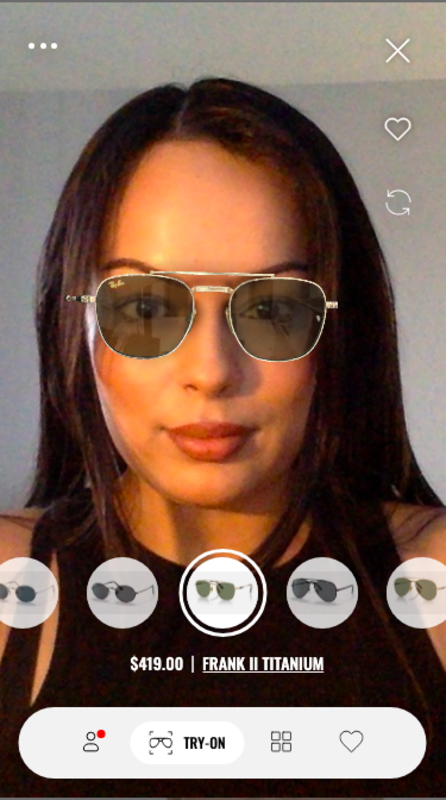
Photo: Kish Lal
To wrap up my VTO experiment, I decided to end on what I thought would be a pretty easy win: sunglasses. Eyewear filters feel almost rudimentary at this point, thanks to early iterations on Snapchat, Instagram and, now, TikTok. So, Ray-Ban would surely have me sorted with trying on gorgeous styles from the comfort of my couch with its Frame Advisor Technology, which scans faces "to analyze your face shape, size and features."
After agreeing to a long privacy policy I most definitely didn't read, my face was scanned, and I was told to wait as it "curated a selection of styles" based on my personal data. I was then prompted to choose from four different styles: Legendary (for classic Ray-Ban styles), Trending Now (for edgier options), Simple and Casual (for everyday styles) and, finally, Advanced (for glasses implemented with "the latest tech"). I made my selection; however, upon clicking "Trending Now," the screen went blank. A few refreshes later, I was finally able to try on different Ray-Ban styles using the live try-on, and, surprisingly, despite a lag and issues up top, the sunglasses were fitted to my face quite well. They didn't glitch while I moved my head up, down and side to side, and every style fit realistically enough. Even as I pushed some of my hair to the front of my face, the sunglasses didn't glitch.
8/10
Takeaway
VTO has some ways to go in order to really, significantly change the retail space. At most, it's a fun way to gameify the online shopping experience. But does it enhance it? In most cases, even for brands with money to burn, the technology isn't seamless or realistic enough to align with customer expectations — especially for Gen-Z and millennial shoppers who use filters regularly and aren't impressed with rudimentary VTO that simply pastes clothing onto their bodies. There have been advancements in technology since its popularization in the pandemic, but there's still a lot to be desired.
Never miss the latest fashion industry news. Sign up for the Fashionista daily newsletter.

